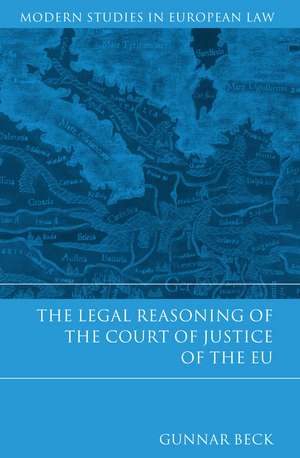The Legal Reasoning of the Court of Justice of the EU: Modern Studies in European Law
Autor Gunnar Becken Limba Engleză Hardback – 20 ian 2013
Din seria Modern Studies in European Law
- 30%
 Preț: 575.75 lei
Preț: 575.75 lei - 24%
 Preț: 440.21 lei
Preț: 440.21 lei - 31%
 Preț: 594.77 lei
Preț: 594.77 lei - 30%
 Preț: 570.22 lei
Preț: 570.22 lei -
 Preț: 181.55 lei
Preț: 181.55 lei - 30%
 Preț: 541.93 lei
Preț: 541.93 lei - 30%
 Preț: 507.97 lei
Preț: 507.97 lei - 30%
 Preț: 790.77 lei
Preț: 790.77 lei - 34%
 Preț: 509.45 lei
Preț: 509.45 lei - 30%
 Preț: 511.64 lei
Preț: 511.64 lei - 19%
 Preț: 296.91 lei
Preț: 296.91 lei - 30%
 Preț: 571.34 lei
Preț: 571.34 lei - 19%
 Preț: 296.72 lei
Preț: 296.72 lei - 11%
 Preț: 375.73 lei
Preț: 375.73 lei - 30%
 Preț: 539.57 lei
Preț: 539.57 lei - 30%
 Preț: 595.65 lei
Preț: 595.65 lei - 27%
 Preț: 475.10 lei
Preț: 475.10 lei - 30%
 Preț: 572.80 lei
Preț: 572.80 lei - 30%
 Preț: 721.14 lei
Preț: 721.14 lei - 18%
 Preț: 320.53 lei
Preț: 320.53 lei - 18%
 Preț: 321.66 lei
Preț: 321.66 lei - 30%
 Preț: 600.57 lei
Preț: 600.57 lei - 19%
 Preț: 317.21 lei
Preț: 317.21 lei - 30%
 Preț: 571.34 lei
Preț: 571.34 lei -
 Preț: 464.01 lei
Preț: 464.01 lei -
 Preț: 239.77 lei
Preț: 239.77 lei - 30%
 Preț: 538.03 lei
Preț: 538.03 lei - 23%
 Preț: 418.50 lei
Preț: 418.50 lei - 29%
 Preț: 587.97 lei
Preț: 587.97 lei - 30%
 Preț: 774.62 lei
Preț: 774.62 lei - 30%
 Preț: 570.43 lei
Preț: 570.43 lei - 30%
 Preț: 574.10 lei
Preț: 574.10 lei - 28%
 Preț: 495.80 lei
Preț: 495.80 lei - 30%
 Preț: 575.33 lei
Preț: 575.33 lei - 30%
 Preț: 571.24 lei
Preț: 571.24 lei - 30%
 Preț: 510.34 lei
Preț: 510.34 lei - 20%
 Preț: 219.19 lei
Preț: 219.19 lei - 30%
 Preț: 601.69 lei
Preț: 601.69 lei - 30%
 Preț: 513.60 lei
Preț: 513.60 lei - 18%
 Preț: 305.72 lei
Preț: 305.72 lei - 30%
 Preț: 972.83 lei
Preț: 972.83 lei - 30%
 Preț: 515.24 lei
Preț: 515.24 lei - 30%
 Preț: 539.99 lei
Preț: 539.99 lei - 30%
 Preț: 570.83 lei
Preț: 570.83 lei - 30%
 Preț: 571.82 lei
Preț: 571.82 lei - 29%
 Preț: 554.35 lei
Preț: 554.35 lei - 30%
 Preț: 572.06 lei
Preț: 572.06 lei - 13%
 Preț: 258.15 lei
Preț: 258.15 lei - 30%
 Preț: 574.59 lei
Preț: 574.59 lei
Preț: 604.98 lei
Preț vechi: 768.20 lei
-21% Nou
Puncte Express: 907
Preț estimativ în valută:
115.77€ • 121.42$ • 96.37£
115.77€ • 121.42$ • 96.37£
Carte tipărită la comandă
Livrare economică 01-15 aprilie
Preluare comenzi: 021 569.72.76
Specificații
ISBN-13: 9781849463232
ISBN-10: 1849463239
Pagini: 486
Dimensiuni: 156 x 234 x 15 mm
Greutate: 0.89 kg
Ediția:New.
Editura: Bloomsbury Publishing
Colecția Hart Publishing
Seria Modern Studies in European Law
Locul publicării:London, United Kingdom
ISBN-10: 1849463239
Pagini: 486
Dimensiuni: 156 x 234 x 15 mm
Greutate: 0.89 kg
Ediția:New.
Editura: Bloomsbury Publishing
Colecția Hart Publishing
Seria Modern Studies in European Law
Locul publicării:London, United Kingdom
Caracteristici
This book considers whether The European Court of Justice is a motor of integration or a judicial law-maker.In the first part of the book the author develops a new heuristic theory of legal reasoning which argues that legal uncertainty is a pervasive and inescapable feature of primary legal material and judicial reasoning alike.The second part of the book examines the jurisprudence of the Court of Justice of the EU against this theoretical framework.
Notă biografică
Gunnar Beck is a Reader in EU Law and Legal Theory at SOAS, University of London, and a Barrister at 1 Essex Court (Chambers of Sir Tony Baldry MP).
Cuprins
Introduction Part I The General Structure of Legal Reasoning1: Scientific versus Heuristic Legal Reasoning 2: The Sources of Linguistic Vagueness 3: Value Pluralism and Absence of a Hierarchy of Norms 4: Precedent and the 'No Law' Situation as Sources of Legal Uncertainty 5: Legal Reasoning - The Interpretative Stage Part II The Legal Reasoning of the Court of Justice of the EU 6: Vagueness and Value Pluralism In the Primary Materials of the EU Legal Order 7: The Legal Reasoning of the Court of Justice I - The Available Topoi 8: The Legal Reasoning of the Court of Justice II - The Approach to Precedent 9: The Legal Reasoning of the Court of Justice III - The Cumulative Approach 10: The Legal Reasoning of the Court of Justice IV - The In-Built Communautaire Tendency of the Cumulative Approach 11: The Legal Reasoning of the Court of Justice V - The Steadying Factors
Recenzii
The book is complete and straightforward and raises a number of timely issues while giving the reader an idea of the workings behind legislative practices of the CJEU. The book is also a good guide to EU cases on the subject of integration and development of the Treaty provisions, given their variety and extensive treatment. This is a very pleasant work to read, both interesting and very up-to-date. The book will certainly be of use to all concerned with theory of legal reasoning, EU law and operation of the Court of Justice of the European Union.
...a real delight to specialists in the theory of European law.
...a real delight to specialists in the theory of European law.
Descriere
The Court of Justice has often been characterised both as a motor of integration and a judicial law-maker. This book examines the Court's jurisprudence over more than half a century, and assesses the extent to which this is a fair description.
